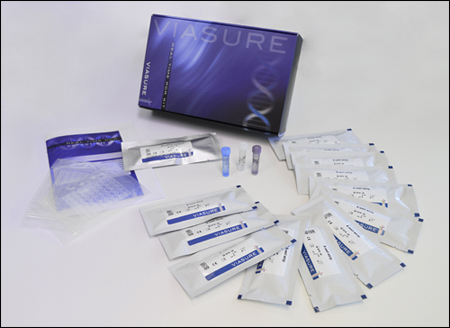
VIASURE Real Time PCR Detection Kits
C. pneumoniae, M. pneumoniae & L. pneumophila

Description
VIASURE C. pneumoniae, M. pneumoniae & L. pneumophila Real Time PCR Detection Kit is designed for specific identification and differentiation of human Chlamydophila pneumoniae, Mycoplasma pneumoniae and Legionella pneumophila in clinical samples from patients with signs and symptoms of respiratory infection.
This test is intended for use as an aid in the diagnosis of Chlamydophila pneumoniae, Mycoplasma pneumoniae and/or Legionella pneumophila in combination with clinical and epidemiological risk factors.
DNA is extracted from clinical specimens, multiplied using Real Time amplification and detected using specific primers and a fluorescent reporter dye probe for Chlamydophila pneumoniae, Mycoplasma pneumoniae and/or Legionella pneumophila.
Specifications
The Medical Device License (MDL) for this Class II in vitro diagnostic product for commercialization in Canada has been funded by the 2025 International Certification aid program of the Official Chamber of Commerce, Industry, Services and Navigation of Spain.

Information
Community-acquired pneumonia (CAP) is a major respiratory disease with a high prevalence in the general population, clinical heterogeneity and variable severity. Pneumonia usually causes symptoms for 3–4 weeks, and daily activities may be impaired for a further 3 weeks on average.
Chlamydophila pneumoniae, Mycoplasma pneumoniae and Legionella pneumophila, are some of the causes of community-acquired pneumonia.
Legionella pneumophila, the bacterium responsible for Legionnaires’ disease, was identified in 1976 after a large outbreak at a hotel in Philadelphia, USA. The most common form of transmission of Legionella is inhalation of contaminated aerosols produced in conjunction with water sprays. Infection can also occur by aspiration of contaminated water or ice, particularly in susceptible hospital patients. Legionnaires’ disease has an incubation period of 2 to 10 days. Untreated Legionnaires’ disease usually worsens during the first week. Combining urine antigen testing with culture or molecular assays currently provides the best algorithm for diagnosis of Legionella disease.
Chlamydophila pneumoniae cause illness by damaging the lining of the respiratory tract (throat, windpipe, and lungs). C. pneumoniae respiratory infection occurs worldwide and in all age groups. The seroprevalence to Chlamydophila pneumoniae is low in infants but it can be higher than 50% in adults. Seroepidemioloical studies show that 50 to 75% of adults have antibodies against Chlamydophila pneumoniae. Most people are infected and reinfected throughout their life. However, not everyone who is exposed to Chlamydophila pneumoniae develops neumonia. Chlamydia pneumoniae has been associated with the establishment of ateromatous disease and heart attacks.
Mycoplasma pneumoniae infection is a mild illness that is most common in young adults and school-aged children. Outbreaks of Mycoplasma pneumoniae occur mostly in crowded environments, when small droplets of water that contain the bacteria get into the air by coughing and sneezing while in close contact with others. The incubation period is usually between 1 to 4 weeks.
The diagnosis of CAP caused by Mycoplasma pneumoniae and Chlamydophila pneumoniae is traditionally based on cultures and serology, which have special requirements and are time-consuming.

